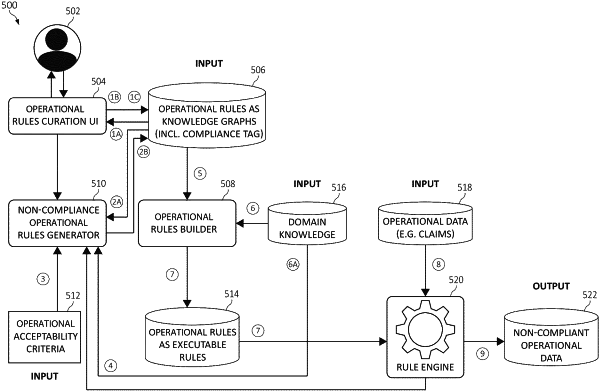| CPC G06Q 30/018 (2013.01) [G06N 5/02 (2013.01)] | 18 Claims |

|
1. A method for implementing intelligent application of operational rules in a computing environment by a processor comprising:
extracting one or more operational rules from a combination of:
a knowledge graph constructed by processing at least textual data from one or more policy documents, the policy documents including policy criteria therein; and
a domain knowledge describing one or more operational policies and conditions,
wherein the one or more operational rules are each in a structured format including information structured into a body corresponding to one or more assumptions of the conditions, and a head corresponding to a conclusion having a value of valid or invalid, and wherein the information of the one or more operational rules are represented in the knowledge graph and necessitate formalizing to convert the one or more operational rules into one or more executable rules automatically executable by a rule engine;
for each respective operational rule of the one or more operational rules, generating candidate non-compliant operational rules by flipping a condition value of a rule condition of each combination of condition-value pairs of the respective operational rule to represent an inverse of the rule condition of each combination of the condition-value pairs, wherein each of the flipped condition values of the rules of each combination of condition-value pairs is output as a list of complemented condition values;
identifying, from the list of complemented condition values, which of the combination of condition-value pairs necessarily is complemented to transform the respective operational rule into one of the candidate non-compliant operational rules, wherein the identifying is performed by determining a statistically significant number of the one or more operational rules become non-compliant rules when the identified combination of condition-value pairs exists on the list of complemented condition values;
executing machine learning logic using the one or more operational rules, the knowledge graph, and the domain knowledge as training data to generate one or more noncompliant operational rules, wherein the one or more non-compliant operational rules comprise those of the candidate non-compliant operational rules that, when applied to operational data, invalidate fewer than a predetermined percentage of claims defined by the one or more operational policies and conditions;
updating the one or more operational rules to incorporate the one or more non-compliant operational rules;
applying the updated one or more operational rules, having incorporated the one or more noncompliant operational rules, to the operational data; and
identifying and filtering non-compliant operational data using the applied updated one or more operational rules.
|